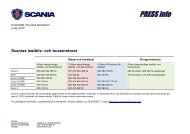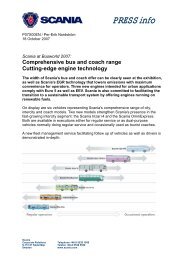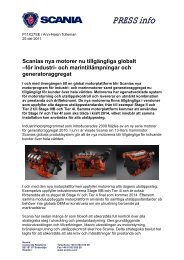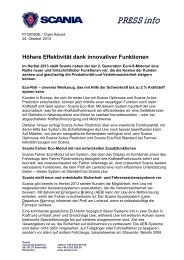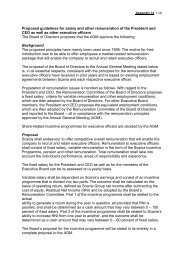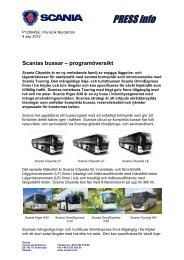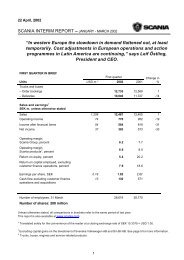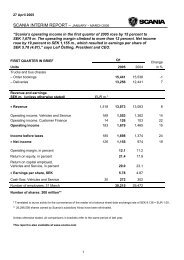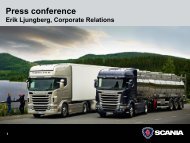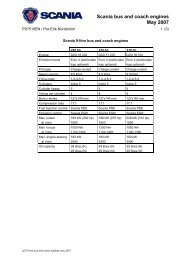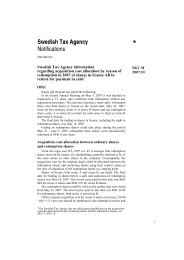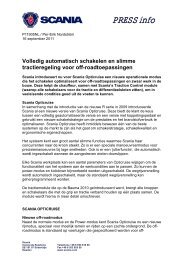Scania annual report 2004
Scania annual report 2004
Scania annual report 2004
Create successful ePaper yourself
Turn your PDF publications into a flip-book with our unique Google optimized e-Paper software.
ENVIRONMENTAL ECONOMICS<br />
Efforts to improve conservation of resources and reduce emissions and discharges<br />
are cost-effective and benefit the environment. Every year, <strong>Scania</strong><br />
follows up its raw material and chemical consumption use, as well as energy<br />
and water use, measured against Group-wide environmental targets.<br />
Environment and economics<br />
During <strong>2004</strong>, <strong>Scania</strong>’s costs for raw materials,<br />
chemicals, energy and water totalled<br />
about SEK 2,048 m., equivalent to 3.6<br />
percent of <strong>Scania</strong>’s sales.<br />
Emissions of carbon dioxide from<br />
<strong>Scania</strong>’s production plants totalled 74,000<br />
tonnes. In relation to <strong>Scania</strong>’s sales, this<br />
represented 1.3 g/SEK. Emissions per<br />
vehicle produced declined compared to<br />
the year before. Efforts to reduce climateaffecting<br />
emissions occur with the support<br />
of <strong>Scania</strong>’s position on the climate issue.<br />
This position and a detailed account of<br />
environmental performance in the production<br />
organisation can be found on <strong>Scania</strong>’s<br />
website, www.scania.com.<br />
Environmental investments<br />
The conventional definition of an environmental<br />
investment is an investment carried<br />
out only for environmental reasons and<br />
aimed at reducing external environmental<br />
impact. This definition follows, among<br />
other things, the European Commission’s<br />
recommendations on voluntary environmental<br />
<strong>report</strong>ing.<br />
An investment is usually motivated by<br />
several different reasons, of which environmental<br />
impact may be one. <strong>Scania</strong> prefers<br />
to take the environment directly into<br />
account when making investments, instead<br />
of subsequently working with filters<br />
and separate purification units.<br />
With the investment strategy that<br />
<strong>Scania</strong> has chosen, the effect in terms of<br />
environmental improvement per krona of<br />
spending is good. This means that <strong>Scania</strong><br />
does not regard large environmental investments<br />
according to the conventional<br />
definition as goals in themselves. During<br />
<strong>2004</strong>, <strong>Scania</strong>’s investments in production<br />
facilities totalled SEK 2,372 m. Of this,<br />
SEK 14.4 m. was classified as environmental<br />
investments.<br />
Soil inventories and clean-up<br />
Orientation studies and risk assessments<br />
of soil and groundwater contamination<br />
have been completed at all production<br />
facilities.<br />
In Meppel, the Netherlands, most<br />
groundwater pollution that has been detected<br />
has been cleaned up. The task is<br />
expected to continue for at least another<br />
year. In Falun, Sweden, 30 tonnes of soil<br />
were removed and decontaminated due to<br />
an emulsion leakage. Preventive measures<br />
were also undertaken. In Slupsk, Poland,<br />
200 tonnes of oil-polluted soil were removed<br />
and decontaminated; this task is<br />
continuing.<br />
Environmental risk management<br />
<strong>Scania</strong>’s risk management focuses on<br />
preventive measures to protect employees<br />
and the company’s overall assets. Procedures<br />
for managing the risks of environmental<br />
hazards are integrated in the company’s<br />
other risk management work.<br />
Operating permits<br />
The operations at <strong>Scania</strong>’s production<br />
facilities around the world have permits<br />
that comply with national legislation. The<br />
environmental impact from these facilities<br />
consists mainly of emissions to air, discharges<br />
to water, waste products and<br />
noise. In addition to legal requirements<br />
and the conditions included in the permits,<br />
there are also internal requirements and<br />
rules for these operations.<br />
Production volume at the Falun, Sweden<br />
plant is within the framework of the<br />
existing permit. The authorities are examining<br />
an application for expanded operations<br />
and are expected to complete this<br />
task during 2005.<br />
Since <strong>2004</strong>, operations in Katrineholm,<br />
Sweden, have no longer required a permit,<br />
since they have mainly been moved elsewhere.<br />
After soil inventories that showed<br />
no significant disruptions, the property<br />
was sold.<br />
<strong>Scania</strong> has applied for a permit for the<br />
new paintshop in Meppel, the Netherlands,<br />
which is scheduled to go into service<br />
in 2007/2008.<br />
The <strong>Scania</strong> production unit in São<br />
Paulo, Brazil is in the process of renewing<br />
its permit. The new permit is expected to<br />
be ready in 2005.<br />
During <strong>2004</strong> there were no violations<br />
of the existing permit conditions. No incidents<br />
occurred that caused significant<br />
environmental impact or led to major<br />
clean-up expenses.<br />
Environmentally related costs as a<br />
proportion of <strong>Scania</strong>’s sales<br />
Transport services, SEK 1,660 m.<br />
Raw material, SEK 1,690 m.<br />
Energy, SEK 207 m.<br />
Chemicals, SEK 144 m.<br />
Water, SEK 7 m.<br />
Achieving environmental targets<br />
in production<br />
Most of <strong>Scania</strong>’s environmental performance<br />
targets for its production units were<br />
set for <strong>2004</strong>. The efforts of the past five years<br />
have yielded good results, even though<br />
the targets have not been entirely fulfilled.<br />
As <strong>Scania</strong>’s environmental work has<br />
reached a greater degree of maturity, it has<br />
proved increasingly difficult to improve conservation<br />
of resources and reduce emissions<br />
and discharges. Continuous improvements<br />
are an important part of environmental<br />
work. Meanwhile, it is in conjunction<br />
with new investments and renovations<br />
that major improvements are achieved.<br />
Future efforts will focus more clearly on<br />
individual issues. This will allow resources<br />
to be localised where they can be expected<br />
to yield the greatest results. Continued<br />
improvement work will focus primarily on<br />
energy. The target is to reduce energy use<br />
per vehicle, given comparable production<br />
volume and the existing production<br />
structure. This shall be achieved through<br />
continuous improvements and local<br />
energy surveys, followed up by efficiencyimproving<br />
projects.<br />
FACTS ABOUT SCANIA • SCANIA ANNUAL REPORT <strong>2004</strong> 44



